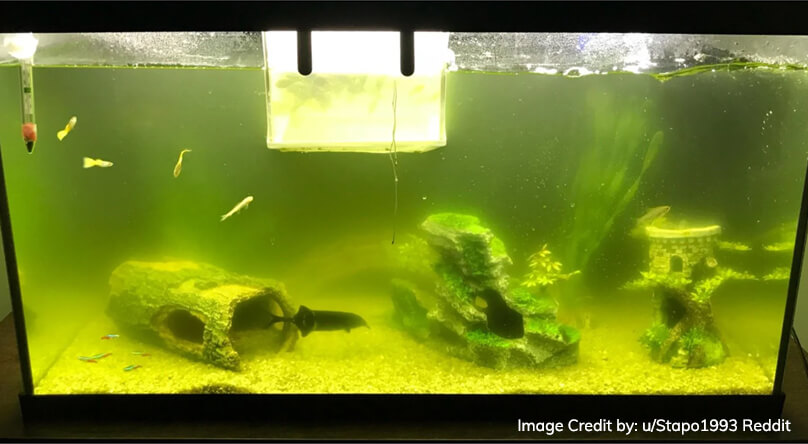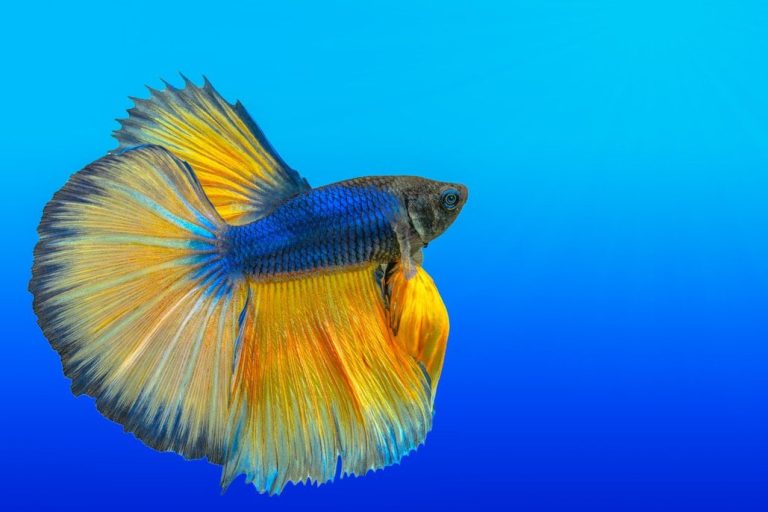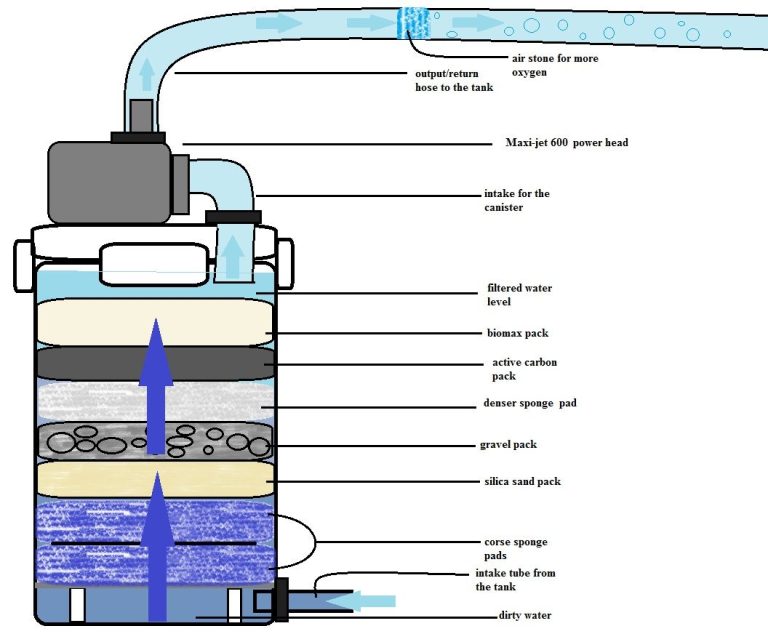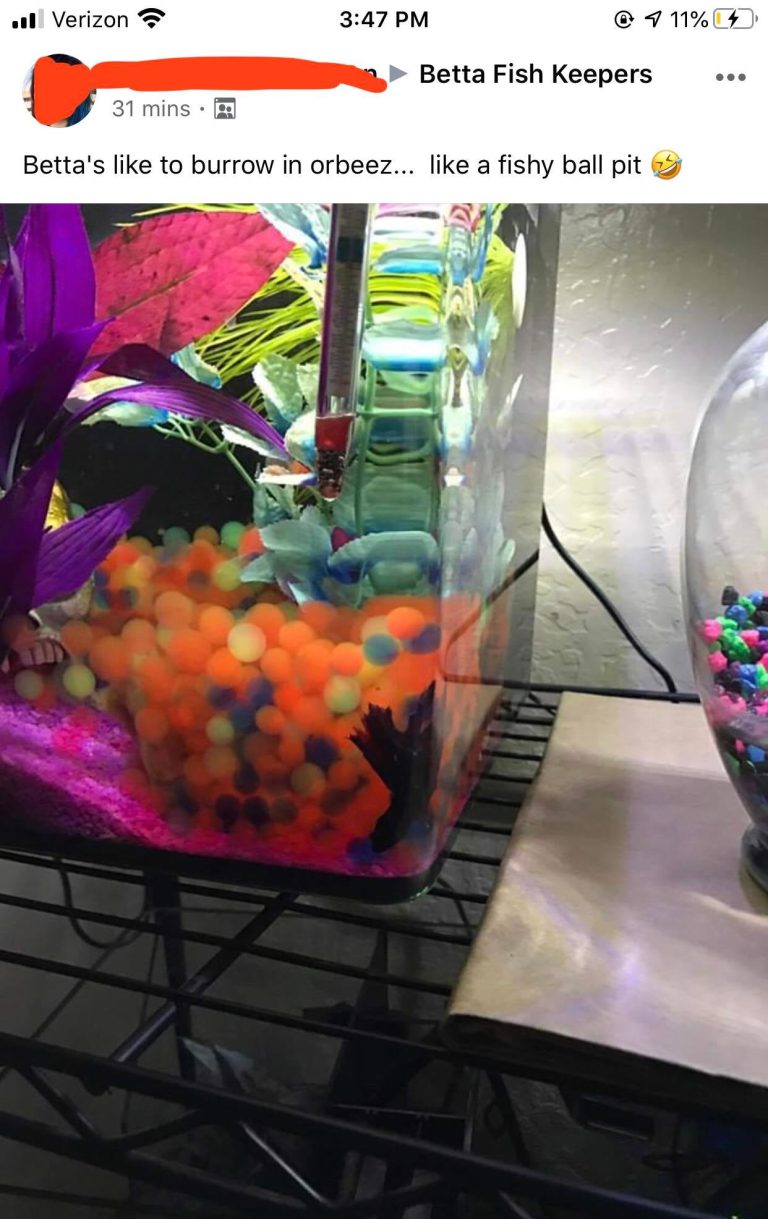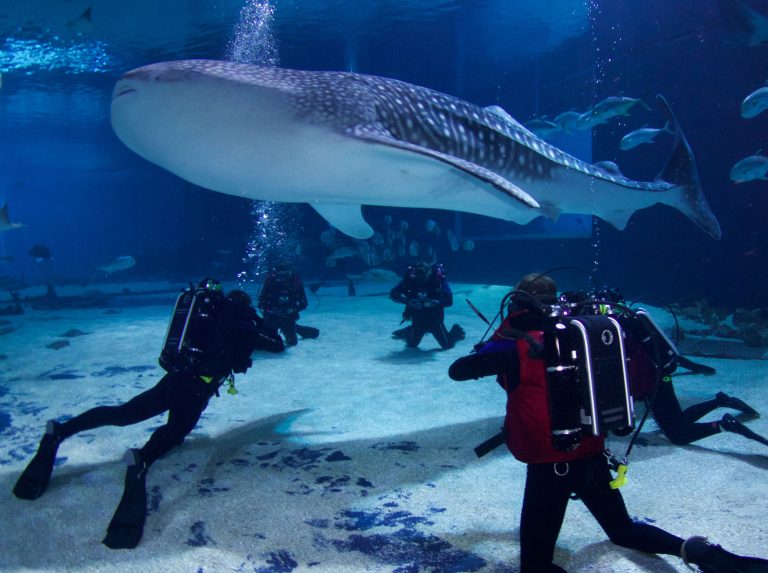Why Does Algae Thrive in Fish Tanks?
Algae grows in fish tanks due to excess nutrients and light exposure. This growth can cause a slew of problems including discolored water, oxygen depletion, and harm to aquatic life.
When a fish tank is exposed to too much light and has an abundance of nutrients from leftover food and waste, algae can thrive and quickly take over. While a small amount of algae can actually benefit a fish tank by providing oxygen, excessive growth can be detrimental to the overall health of the aquarium.
It’s important to regulate light exposure and properly clean the tank to maintain a healthy and balanced ecosystem for your fish. In this article, we will explore the causes and solutions for algae growth in fish tanks.

Credit: www.aquariumcoop.com
Understanding Algae In Fish Tanks
Fish tanks are a beautiful addition to any home or office, but they require maintenance to keep them clean and healthy. One of the most common problems with fish tanks is algae growth. In this blog post, we’ll discuss why algae grow in fish tanks and how to prevent it from happening.
Definition Of Algae
Algae are simple, plant-like organisms that grow in water and require sunlight to survive. Algae can be beneficial to fish tanks by producing oxygen and serving as a food source for some fish. However, when there is an overgrowth of algae, it can become a nuisance.
Algae can cause water discoloration, produce unpleasant odors, and even harm fish.
Types Of Algae Found In Fish Tanks
There are several types of algae that can grow in fish tanks. Here are some of the most common ones:
- Green algae: This type of algae is the most common and grows quickly in areas with high levels of light and nutrients.
- Brown algae: Brown algae are often found in newer tanks and can cover the aquarium walls, rocks, and plants.
- Blue-green algae: Despite its name, blue-green algae are not algae at all but rather bacteria. It grows in patches and can produce toxins harmful to fish.
- Red algae: This type of algae is often found in saltwater tanks and can be difficult to remove.
To prevent algae growth in fish tanks, it’s important to maintain good water quality by performing regular water changes, limiting the amount of light exposure, and avoiding overfeeding. Additionally, adding aquarium plants and algae-eating fish like snails or shrimp can help keep algae growth at bay.
With these tips, you can keep your fish tank clean and healthy for your aquatic pets to thrive.
Factors That Contribute To Algae Growth In Fish Tanks
Why does algae grow in fish tanks: factors that contribute to algae growth in fish tanks
Algae growth is common in fish tanks and can cause an unpleasant sight for fishkeepers. Algae is a living organism that needs specific conditions to flourish, and fish tanks are an ideal environment for it. Several factors contribute to algae growth in fish tanks, including light exposure, nutrients such as nitrates and phosphates, water flow and aeration, and temperature fluctuations.
Light Exposure
Light exposure is essential for the growth of plants and algae. In fish tanks, algae thrives when exposed to visible light for more than 10 hours a day. The intensity and duration of the light directly impact algae growth. To mitigate algae growth, you can reduce the duration of light exposure or install a timer to switch the light off after a specific period.
Additionally, you can place the aquarium in an area with minimal direct sunlight as this will help reduce the growth of algae.
Nutrients Such As Nitrates And Phosphates
Nutrients such as nitrates and phosphates are fuel for the growth of algae. They are commonly found in fish food, fish waste, and other organic matter in the tank. Algae use these nutrients to reproduce, and an excess supply of nutrients in the tank can lead to uncontrollable algae growth.
To reduce the level of nutrients, minimize overfeeding your fish and conduct regular water changes. You can also add aquatic plants to your tank as they absorb nitrates and phosphates, limiting their availability for the algae.
Water Flow And Aeration
Inadequate water flow and aeration in the tank can create a favorable environment for algae to grow. Proper water flow and aeration enable fish waste and other organic matter in the tank to settle and decompose, reducing the availability of nutrients for the algae.
You can install filters, aerators, and water pumps to create sufficient and consistent water flow in the tank. This reduces the stagnation of water and helps control the growth of algae.
Temperature Fluctuations
Temperature fluctuations in the fish tank can significantly affect algae growth. Rapid temperature changes caused by poor heating systems or placing the tank in areas with extreme temperature changes can cause the algae to bloom. Ensure that your tank has a stable temperature to avoid sudden temperature fluctuations.
You can also consider installing a heater that maintains a stable temperature throughout the day and night.
Algae growth is natural in fish tanks and can cause the water to appear cloudy and unsightly. However, by understanding the factors that contribute to its growth, you can take measures to control it. Ensure that your tank has sufficient light exposure, the right levels of nutrients, proper water flow and aeration, and stable temperatures to maintain a healthy and attractive fish tank environment.
The Connection Between Fish And Algae Growth
Did you know that the presence of fish in a tank is directly related to the growth of algae? Yes, it is true! Fish and algae in a tank have a symbiotic relationship, meaning they depend on each other for growth and survival.
Here are some reasons why:
Fish Wastes As A Source Of Nutrients For Algae
Fish excretes waste, which includes nitrogen and phosphorous, that serves as vital nutrients for algae growth. These wastes can build up in the tank, leading to an increase in algae growth. Moreover, leftover fish food can also contribute to excessive algae growth.
That is why it is essential to feed the fish the right amount of food and clean the tank regularly.
Here are some ways to control excessive algae growth:
- Regularly monitor the amount of food given to fish and reduce it if necessary.
- Install a filtration system to remove excess fish wastes before they mix with the water.
- Control the amount of light exposure the tank receives as increased exposure can lead to excessive algae growth.
The Importance Of Fish Tank Maintenance
A clean and well-maintained fish tank not only ensures a happy and healthy fish but also prevents excessive algae growth. Some crucial maintenance tasks include:
- Regularly replacing the water in the tank
- Cleaning the tank with the right aquarium-safe cleaning supplies
- Regularly checking and cleaning the filtration system
- Keeping the tank out of direct sunlight
Remember, a well-maintained aquarium leads to healthy and happy fish, which in turn contributes to minimized algae growth. So, always prioritize regular maintenance of your tank and keep an eye on your fish’s feeding habits and waste outputs to prevent excessive algae growth.
Harmful Effects Of Algae In Fish Tanks
Algae can grow in fish tanks for various reasons; however, this is a common problem that fish-keepers face. This aquatic plant-like organism can be beneficial to fish, but it can also be harmful. Algae bloom, cloudy water, and water discoloration are some issues that can arise due to their overgrowth.
Let’s dive into the topic of harmful effects of algae in fish tanks and its impact on fish and plant health, oxygen depletion and ph fluctuations, and aesthetics and maintenance issues.
Oxygen Depletion And Ph Fluctuations
- Algae requires light, nutrients, and carbon dioxide (co2) to carry out photosynthesis.
- During photosynthesis, algae produce oxygen during the day but switch to producing co2 at night.
- Overgrowth of algae can deplete oxygen levels in the water, making it difficult for fish and other aquatic life to survive.
- When algae die, they decompose, which lowers ph levels and increases the risk of ammonia buildup.
- The sudden changes in ph levels can also stress and harm fish and other aquatic organisms.
Fish And Plant Health
- Algae growth can block sunlight that plants need to photosynthesize, ultimately leading to their death.
- Overgrowth of algae can compete with plants for nutrients.
- Algae can produce toxic by-products that can harm aquatic life, making fish prone to infections and diseases.
- Harmful algal blooms can cause gill damage and disrupt the nervous system of fish.
Aesthetics And Maintenance Issues
- Algae blooms can make the water appear green, brown, or red, which is a nuisance for fish owners who enjoy looking at their fish.
- Uneaten fish food and waste can contribute to algae growth, which requires frequent cleaning and maintenance of the tank.
- Algae can cover tank surfaces, including filters, pumps, and tubing, which can lead to equipment malfunctioning.
- Algae, when left unchecked, can cause an unpleasant smell and taste in the water and can be unappealing to fish owners.
It’s essential to have a balanced and healthy aquarium ecosystem. While algae growth is natural, it’s crucial to control it from overgrowing as it can be harmful to fish and other aquatic organisms. Regular maintenance and water testing can help prevent and control algae overgrowth.
By taking proper care of the aquarium, you can ensure that your fish thrive in a clean and healthy environment.
Prevention And Control Of Algae In Fish Tanks
Algae growth is a common issue among fish tank enthusiasts. Not only can it look unsightly, but it can also harm the health of the fish living in the tank. Prevention and control of algae growth is essential for maintaining the overall health and aesthetic appeal of your fish tank.
Here, we will discuss the natural and chemical methods for algae control, as well as the importance of proper fish tank maintenance.
Natural Methods For Algae Control
If you prefer to use natural methods for algae control, there are several options available to you. These methods include:
- Limiting light exposure: Algae need light to grow, so reducing the amount of exposure they receive can help prevent their growth. Be sure to avoid placing the tank in direct sunlight or leaving the lights on for too long.
- Live plants: Adding live plants to the aquarium can help absorb excess nutrients that would otherwise fuel algae growth. Some great options include java moss, amazon sword, and anacharis.
- Manual removal: Gently scrubbing the algae off the tank walls and decorations can help control its growth. However, be cautious not to disturb the ecosystem of the tank or harm the fish.
Chemical Treatments For Algae Control
If natural methods are not effective, chemical treatments can be used to control algae growth. However, it is important to follow instructions and use these treatments carefully as they can be harmful to fish. Recommended chemical treatments include:
- Algaecides: These treatments work by killing off the algae but can also harm any beneficial bacteria in the tank. It is recommended to use them only as a last resort.
- Uv sterilizers: These devices use ultraviolet light to kill off algae and other microorganisms in the water. They are highly effective in controlling algae growth but can be quite expensive.
The Role Of Proper Fish Tank Maintenance
Proper fish tank maintenance is crucial in controlling algae growth. Here are some tips to maintain an algae-free environment:
- Consistent water changes: Regular water changes help remove excess nutrients before they can fuel the growth of algae.
- Proper filtration: A good filtration system is essential to maintain a healthy environment for fish and prevent algae growth.
- Avoid overfeeding: Overfeeding can lead to excess nutrients in the water, which can promote the growth of algae.
Controlling algae growth in fish tanks is essential for maintaining a healthy and aesthetically pleasing environment for your fish. Using natural methods, chemical treatments, and proper fish tank maintenance can help prevent and control the growth of algae. Remember to always follow instructions and be cautious when using any chemicals in your tank.
Frequently Asked Questions Of Why Does Algae Grow In Fish Tanks
Why Does Algae Grow In Fish Tanks?
Algae grows in fish tank due to excess nutrients from fish waste and light exposure.
How Can Algae Growth Be Prevented?
Algae growth can be prevented by reducing light exposure, keeping tank clean, and maintaining water quality.
Is Algae Harmful To Fish In The Tank?
Algae is not harmful to fish in the tank, but excessive growth can lead to oxygen depletion and affect water quality.
How To Get Rid Of Excess Algae In A Fish Tank?
Excess algae in a fish tank can be removed manually or by using algae eaters or chemical treatments.
Conclusion
Algae growth in fish tanks could spell disaster for your fish pets if left uncontrolled. Fortunately, there are many ways to prevent or manage algae growth in your aquarium. By ensuring proper filtration, reducing light exposure, and avoiding overfeeding, you can keep your tank clean and algae-free.
Additionally, introducing aquatic plants and algae eaters into your tank can also help to keep things balanced. Proper maintenance and vigilance are key to achieving an optimal environment for your fish. Keep in mind that algae growth may not be entirely preventable, so regular cleaning and water changes are important.
By paying attention to the factors that contribute to algae growth and taking the necessary steps to manage it, you can ensure the health and well-being of your aquatic pets.
